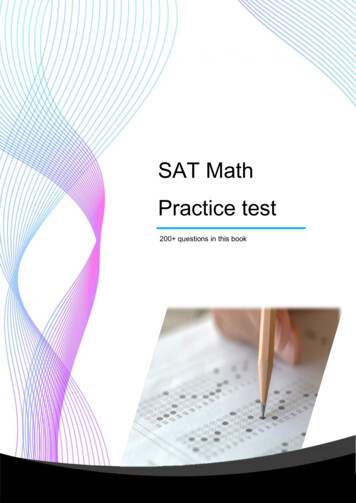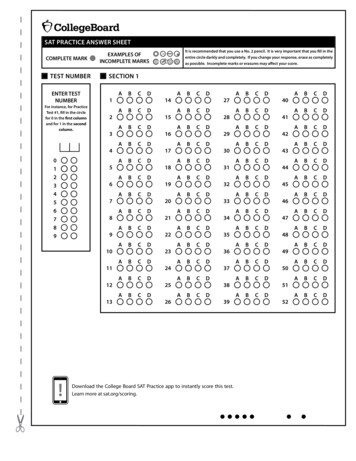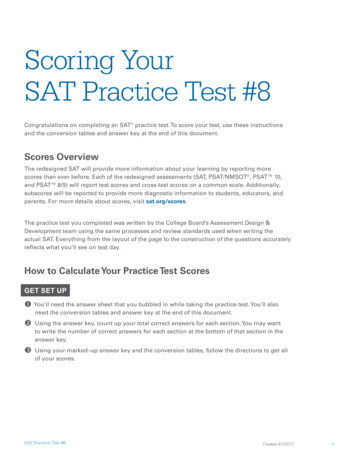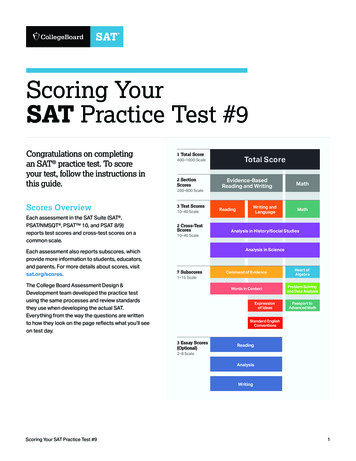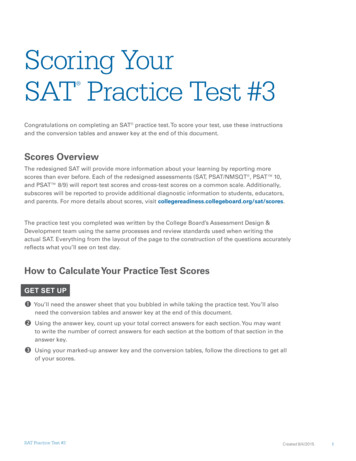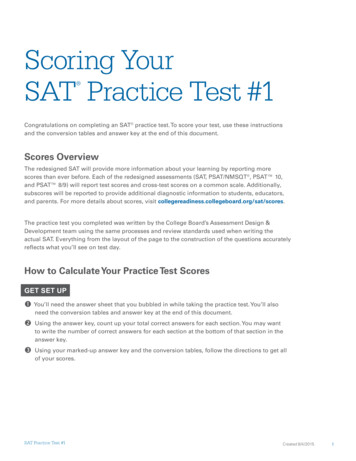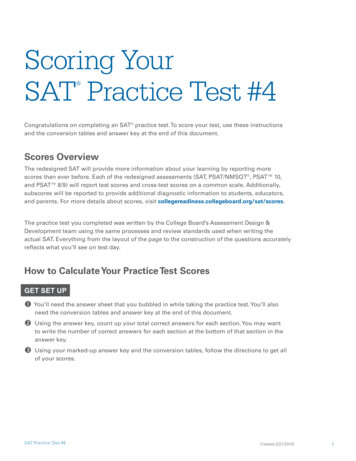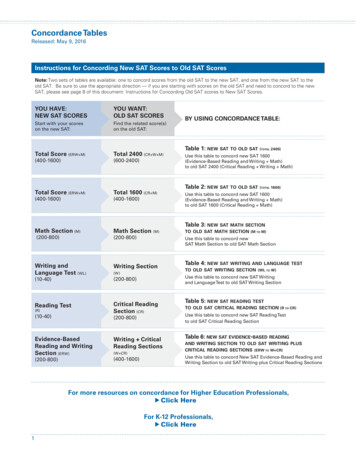
Transcription
SAT Practice Test #1 IMPORTANT REMINDERSA No. 2 pencil is required for the test.Do not use a mechanical pencil or pen.Sharing any questions with anyoneis a violation of Test Securityand Fairness policies and may resultin your scores being canceled.This cover is representative of what you’ll see on test day.THIS TEST BOOK MUST NOT BE TAKEN FROM THE ROOM. UNAUTHORIZEDREPRODUCTION OR USE OF ANY PART OF THIS TEST BOOK IS PROHIBITED. 2015 The College Board. College Board, SAT, and the acorn logo are registered trademarks of the College Board.
Test begins on the next page.
11Reading Test65 M I NU TES, 5 2 QUESTIONSTurn to Section 1 of your answer sheet to answer the questions in this section.DIRECTIONSEach passage or pair of passages below is followed by a number of questions. After readingeach passage or pair, choose the best answer to each question based on what is stated orimplied in the passage or passages and in any accompanying graphics (such as a table orgraph).This passage is from Lydia Minatoya, The Strangeness ofBeauty. 1999 by Lydia Minatoya. The setting is Japan in1920. Chie and her daughter Naomi are members of theHouse of Fuji, a noble family.Line5101520Akira came directly, breaking all tradition. Wasthat it? Had he followed form—had he asked hismother to speak to his father to approach ago-between—would Chie have been more receptive?He came on a winter’s eve. He pounded on thedoor while a cold rain beat on the shuttered veranda,so at first Chie thought him only the wind. The maidknew better. Chie heard her soft scuttling footsteps,the creak of the door. Then the maid brought acalling card to the drawing room, for Chie.Chie was reluctant to go to her guest; perhaps shewas feeling too cozy. She and Naomi were reading ata low table set atop a charcoal brazier. A thick quiltspread over the sides of the table so their legs weretucked inside with the heat.“Who is it at this hour, in this weather?” Chiequestioned as she picked the name card off themaid’s lacquer tray.“Shinoda, Akira. Kobe Dental College,” she read.Naomi recognized the name. Chie heard a softintake of air.“I think you should go,” said Naomi.Unauthorized copying or reuse of any part of this page is illegal.Questions 1-10 are based on the followingpassage.2530354045502Akira was waiting in the entry. He was in his earlytwenties, slim and serious, wearing the blackmilitary-style uniform of a student. As hebowed—his hands hanging straight down, ablack cap in one, a yellow oil-paper umbrella in theother—Chie glanced beyond him. In the glisteningsurface of the courtyard’s rain-drenched pavingstones, she saw his reflection like a dark double.“Madame,” said Akira, “forgive my disruption,but I come with a matter of urgency.”His voice was soft, refined. He straightened andstole a deferential peek at her face.In the dim light his eyes shone with sincerity.Chie felt herself starting to like him.“Come inside, get out of this nasty night. Surelyyour business can wait for a moment or two.”“I don’t want to trouble you. Normally I wouldapproach you more properly but I’ve received wordof a position. I’ve an opportunity to go to America, asdentist for Seattle’s Japanese community.”“Congratulations,” Chie said with amusement.“That is an opportunity, I’m sure. But how am Iinvolved?”Even noting Naomi’s breathless reaction to thename card, Chie had no idea. Akira’s message,delivered like a formal speech, filled her withmaternal amusement. You know how children speakso earnestly, so hurriedly, so endearingly aboutthings that have no importance in an adult’s mind?That’s how she viewed him, as a child.CO NTI N U E
16065707580859095It was how she viewed Naomi. Even thoughNaomi was eighteen and training endlessly in the artsneeded to make a good marriage, Chie had made noeffort to find her a husband.Akira blushed.“Depending on your response, I may stay inJapan. I’ve come to ask for Naomi’s hand.”Suddenly Chie felt the dampness of the night.“Does Naomi know anything of your . . .ambitions?”“We have an understanding. Please don’t judgemy candidacy by the unseemliness of this proposal. Iask directly because the use of a go-between takesmuch time. Either method comes down to the samething: a matter of parental approval. If you give yourconsent, I become Naomi’s yoshi.* We’ll live in theHouse of Fuji. Without your consent, I must go toAmerica, to secure a new home for my bride.”Eager to make his point, he’d been looking her fullin the face. Abruptly, his voice turned gentle. “I seeI’ve startled you. My humble apologies. I’ll take nomore of your evening. My address is on my card. Ifyou don’t wish to contact me, I’ll reapproach you intwo weeks’ time. Until then, good night.”He bowed and left. Taking her ease, with effortlessgrace, like a cat making off with a fish.“Mother?” Chie heard Naomi’s low voice andturned from the door. “He has asked you?”The sight of Naomi’s clear eyes, her dark browsgave Chie strength. Maybe his hopes werepreposterous.“Where did you meet such a fellow? Imagine! Hethinks he can marry the Fuji heir and take her toAmerica all in the snap of his fingers!”Chie waited for Naomi’s ripe laughter.Naomi was silent. She stood a full half minutelooking straight into Chie’s eyes. Finally, she spoke.“I met him at my literary meeting.”Naomi turned to go back into the house, thenstopped.“Mother.”“Yes?”“I mean to have him.”.551* a man who marries a woman of higher status and takes herfamily’s nameUnauthorized copying or reuse of any part of this page is illegal.31Which choice best describes what happens in thepassage?A) One character argues with another characterwho intrudes on her home.B) One character receives a surprising request fromanother character.C) One character reminisces about choices she hasmade over the years.D) One character criticizes another character forpursuing an unexpected course of action.2Which choice best describes the developmentalpattern of the passage?A) A careful analysis of a traditional practiceB) A detailed depiction of a meaningful encounterC) A definitive response to a series of questionsD) A cheerful recounting of an amusing anecdote3As used in line 1 and line 65, “directly” mostnearly meansA) frankly.B) confidently.C) without mediation.D) with precision.4Which reaction does Akira most fear from Chie?A) She will consider his proposal inappropriate.B) She will mistake his earnestness for immaturity.C) She will consider his unscheduled visit animposition.D) She will underestimate the sincerity of hisemotions.CO NTI N U E
1Which choice provides the best evidence for theanswer to the previous question?A) Line 33 (“His voice . . . refined”)B) Lines 49-51 (“You . . . mind”)C) Lines 63-64 (“Please . . . proposal”)D) Lines 71-72 (“Eager . . . face”)6In the passage, Akira addresses Chie withA) affection but not genuine love.B) objectivity but not complete impartiality.C) amusement but not mocking disparagement.D) respect but not utter deference.7The main purpose of the first paragraph is toA) describe a culture.B) criticize a tradition.C) question a suggestion.D) analyze a reaction.8As used in line 2, “form” most nearly meansA) appearance.B) custom.C) structure.D) nature.Unauthorized copying or reuse of any part of this page is illegal.519Why does Akira say his meeting with Chie is“a matter of urgency” (line 32)?A) He fears that his own parents will disapprove ofNaomi.B) He worries that Naomi will reject him and marrysomeone else.C) He has been offered an attractive job in anothercountry.D) He knows that Chie is unaware of his feelings forNaomi.10Which choice provides the best evidence for theanswer to the previous question?A) Line 39 (“I don’t . . . you”)B) Lines 39-42 (“Normally . . . community”)C) Lines 58-59 (“Depending . . . Japan”)D) Lines 72-73 (“I see . . . you”)4CO NTI N U E
11.Questions 11-21 are based on the followingpassage and supplementary material.This passage is adapted from Francis J. Flynn and GabrielleS. Adams, "Money Can't Buy Love: Asymmetric Beliefs aboutGift Price and Feelings of Appreciation." 2008 by ElsevierInc.Line510152025303540Every day, millions of shoppers hit the stores infull force—both online and on foot—searchingfrantically for the perfect gift. Last year, Americansspent over 30 billion at retail stores in the month ofDecember alone. Aside from purchasing holidaygifts, most people regularly buy presents for otheroccasions throughout the year, including weddings,birthdays, anniversaries, graduations, and babyshowers. This frequent experience of gift-giving canengender ambivalent feelings in gift-givers. Manyrelish the opportunity to buy presents becausegift-giving offers a powerful means to build strongerbonds with one’s closest peers. At the same time,many dread the thought of buying gifts; they worrythat their purchases will disappoint rather thandelight the intended recipients.Anthropologists describe gift-giving as a positivesocial process, serving various political, religious, andpsychological functions. Economists, however, offera less favorable view. According to Waldfogel (1993),gift-giving represents an objective waste of resources.People buy gifts that recipients would not choose tobuy on their own, or at least not spend as muchmoney to purchase (a phenomenon referred to as‘‘the deadweight loss of Christmas”). To wit, giversare likely to spend 100 to purchase a gift thatreceivers would spend only 80 to buy themselves.This ‘‘deadweight loss” suggests that gift-givers arenot very good at predicting what gifts others willappreciate. That in itself is not surprising to socialpsychologists. Research has found that people oftenstruggle to take account of others’ perspectives—their insights are subject to egocentrism, socialprojection, and multiple attribution errors.What is surprising is that gift-givers haveconsiderable experience acting as both gift-givers andgift-recipients, but nevertheless tend to overspendeach time they set out to purchase a meaningful gift.In the present research, we propose a uniquepsychological explanation for this overspendingproblem—i.e., that gift-givers equate how much theyUnauthorized copying or reuse of any part of this page is illegal.54550556065707580spend with how much recipients will appreciate thegift (the more expensive the gift, the stronger agift-recipient’s feelings of appreciation). Although alink between gift price and feelings of appreciationmight seem intuitive to gift-givers, such anassumption may be unfounded. Indeed, we proposethat gift-recipients will be less inclined to base theirfeelings of appreciation on the magnitude of a giftthan givers assume.Why do gift-givers assume that gift price is closelylinked to gift-recipients’ feelings of appreciation?Perhaps givers believe that bigger (i.e., moreexpensive) gifts convey stronger signals ofthoughtfulness and consideration. According toCamerer (1988) and others, gift-giving represents asymbolic ritual, whereby gift-givers attempt to signaltheir positive attitudes toward the intended recipientand their willingness to invest resources in a futurerelationship. In this sense, gift-givers may bemotivated to spend more money on a gift in order tosend a “stronger signal” to their intended recipient.As for gift-recipients, they may not construe smallerand larger gifts as representing smaller and largersignals of thoughtfulness and consideration.The notion of gift-givers and gift-recipients beingunable to account for the other party’s perspectiveseems puzzling because people slip in and out ofthese roles every day, and, in some cases, multipletimes in the course of the same day. Yet, despite theextensive experience that people have as both giversand receivers, they often struggle to transferinformation gained from one role (e.g., as a giver)and apply it in another, complementary role (e.g., asa receiver). In theoretical terms, people fail to utilizeinformation about their own preferences andexperiences in order to produce more efficientoutcomes in their exchange relations. In practicalterms, people spend hundreds of dollars each year ongifts, but somehow never learn to calibrate their giftexpenditures according to personal insight.CO NTI N U E
11Mean eless expensive giftmore expensive gift11The authors most likely use the examples in lines 1-9of the passage (“Every . . . showers”) to highlight theA) regularity with which people shop for gifts.B) recent increase in the amount of money spent ongifts.C) anxiety gift shopping causes for consumers.D) number of special occasions involvinggift-giving.12In line 10, the word “ambivalent” most nearly meansA) unrealistic.B) conflicted.C) apprehensive.D) supportive.Unauthorized copying or reuse of any part of this page is illegal.Givers’ Perceived and Recipients’Actual Gift Appreciations7.0013The authors indicate that people value gift-givingbecause they feel itA) functions as a form of self-expression.B) is an inexpensive way to show appreciation.C) requires the gift-recipient to reciprocate.D) can serve to strengthen a relationship.14Which choice provides the best evidence for theanswer to the previous question?A) Lines 10-13 (“Many . . . peers”)B) Lines 22-23 (“People . . . own”)C) Lines 31-32 (“Research . . . perspectives”)D) Lines 44-47 (“Although . . . unfounded”)15The “social psychologists” mentioned in paragraph 2(lines 17-34) would likely describe the “deadweightloss” phenomenon asA) predictable.B) questionable.C) disturbing.D) unprecedented.16The passage indicates that the assumption made bygift-givers in lines 41-44 may beA) insincere.B) unreasonable.C) incorrect.D) substantiated.6CO NTI N U E
11.17Which choice provides the best evidence for theanswer to the previous question?A) Lines 53-55 (“Perhaps . . . consideration”)B) Lines 55-60 (“According . . . relationship”)C) Lines 63-65 (“As . . . consideration”)D) Lines 75-78 (“In . . . relations”)18As it is used in line 54, “convey” most nearly meansA) transport.B) counteract.C) exchange.D) communicate.19The authors refer to work by Camerer and others(line 56) in order toA) offer an explanation.B) introduce an argument.C) question a motive.D) support a conclusion.Unauthorized copying or reuse of any part of this page is illegal.720The graph following the passage offers evidence thatgift-givers base their predictions of how much a giftwill be appreciated onA) the appreciation level of the gift-recipients.B) the monetary value of the gift.C) their own desires for the gifts they purchase.D) their relationship with the gift-recipients.21The authors would likely attribute the differences ingift-giver and recipient mean appreciation asrepresented in the graph toA) an inability to shift perspective.B) an increasingly materialistic culture.C) a growing opposition to gift-giving.D) a misunderstanding of intentions.CO NTI N U E
1This passage is adapted from J. D. Watson and F. H. C. Crick,“Genetical Implications of the Structure of DeoxyribonucleicAcid.” 1953 by Nature Publishing Group. Watson and Crickdeduced the structure of DNA using evidence from RosalindFranklin and R. G. Gosling’s X-ray crystallography diagramsof DNA and from Erwin Chargaff’s data on the basecomposition of DNA.Line510152025303540The chemical formula of deoxyribonucleic acid(DNA) is now well established. The molecule is avery long chain, the backbone of which consists of aregular alternation of sugar and phosphate groups.To each sugar is attached a nitrogenous base, whichcan be of four different types. Two of the possiblebases—adenine and guanine—are purines, and theother two—thymine and cytosine—are pyrimidines.So far as is known, the sequence of bases along thechain is irregular. The monomer unit, consisting ofphosphate, sugar and base, is known as a nucleotide.The first feature of our structure which is ofbiological interest is that it consists not of one chain,but of two. These two chains are both coiled arounda common fiber axis. It has often been assumed thatsince there was only one chain in the chemicalformula there would only be one in the structuralunit. However, the density, taken with the X-rayevidence, suggests very strongly that there are two.The other biologically important feature is themanner in which the two chains are held together.This is done by hydrogen bonds between the bases.The bases are joined together in pairs, a single basefrom one chain being hydrogen-bonded to a singlebase from the other. The important point is that onlycertain pairs of bases will fit into the structure.One member of a pair must be a purine and the othera pyrimidine in order to bridge between the twochains. If a pair consisted of two purines, forexample, there would not be room for it.We believe that the bases will be present almostentirely in their most probable forms. If this is true,the conditions for forming hydrogen bonds are morerestrictive, and the only pairs of bases possible are:adenine with thymine, and guanine with cytosine.Adenine, for example, can occur on either chain; butwhen it does, its partner on the other chain mustalways be thymine.The phosphate-sugar backbone of our model iscompletely regular, but any sequence of the pairs ofbases can fit into the structure. It follows that in aUnauthorized copying or reuse of any part of this page is illegal.Questions 22-31 are based on the followingpassage and supplementary material.14550long molecule many different permutations arepossible, and it therefore seems likely that the precisesequence of bases is the code which carries thegenetical information. If the actual order of the baseson one of the pair of chains were given, one couldwrite down the exact order of the bases on the otherone, because of the specific pairing. Thus one chainis, as it were, the complement of the other, and it isthis feature which suggests how the deoxyribonucleicacid molecule might duplicate itself.The table shows, for various organisms, the percentage ofeach of the four types of nitrogenous bases in thatorganism’s DNA.Base Composition of DNAPercentage of basein organism’s DNAOrganismadenine guanine cytosine 9.3Sea .318.717.132.9E. coli24.726.025.723.6Adapted from Manju Bansal, “DNA Structure: Revisiting theWatson-Crick Double Helix.” 2003 by Current Science Association,Bangalore.8CO NTI N U E
11.22The authors use the word “backbone” in lines 3and 39 to indicate thatA) only very long chains of DNA can be taken froman organism with a spinal column.B) the main structure of a chain in a DNA moleculeis composed of repeating units.C) a chain in a DNA molecule consists entirely ofphosphate groups or of sugars.D) nitrogenous bases form the main structural unitof DNA.23A student claims that nitrogenous bases pairrandomly with one another. Which of the followingstatements in the passage contradicts the student’sclaim?A) Lines 5-6 (“To each . . . types”)B) Lines 9-10 (“So far . . . irregular”)C) Lines 23-25 (“The bases . . . other”)D) Lines 27-29 (“One member . . . chains”)24In the second paragraph (lines 12-19), what do theauthors claim to be a feature of biological interest?A) The chemical formula of DNAB) The common fiber axisC) The X-ray evidenceD) DNA consisting of two chainsUnauthorized copying or reuse of any part of this page is illegal.925The authors’ main purpose of including theinformation about X-ray evidence and density is toA) establish that DNA is the molecule that carriesthe genetic information.B) present an alternate hypothesis about thecomposition of a nucleotide.C) provide support for the authors’ claim about thenumber of chains in a molecule of DNA.D) confirm the relationship between the density ofDNA and the known chemical formula of DNA.26Based on the passage, the authors’ statement “If apair consisted of two purines, for example, therewould not be room for it” (lines 29-30) implies that apairA) of purines would be larger than the spacebetween a sugar and a phosphate group.B) of purines would be larger than a pair consistingof a purine and a pyrimidine.C) of pyrimidines would be larger than a pair ofpurines.D) consisting of a purine and a pyrimidine would belarger than a pair of pyrimidines.27The authors’ use of the words “exact,” “specific,” and“complement” in lines 47-49 in the final paragraphfunctions mainly toA) confirm that the nucleotide sequences are knownfor most molecules of DNA.B) counter the claim that the sequences of basesalong a chain can occur in any order.C) support the claim that the phosphate-sugarbackbone of the authors’ model is completelyregular.D) emphasize how one chain of DNA may serve as atemplate to be copied during DNA replication.CO NTI N U E
1Based on the table and passage, which choice givesthe correct percentages of the purines in yeast DNA?A) 17.1% and 18.7%B) 17.1% and 32.9%C) 18.7% and 31.3%D) 31.3% and 32.9%29Do the data in the table support the authors’proposed pairing of bases in DNA?A) Yes, because for each given organism, thepercentage of adenine is closest to the percentageof thymine, and the percentage of guanine isclosest to the percentage of cytosine.B) Yes, because for each given organism, thepercentage of adenine is closest to the percentageof guanine, and the percentage of cytosine isclosest to the percentage of thymine.C) No, because for each given organism, thepercentage of adenine is closest to the percentageof thymine, and the percentage of guanine isclosest to the percentage of cytosine.D) No, because for each given organism, thepercentage of adenine is closest to the percentageof guanine, and the percentage of cytosine isclosest to the percentage of thymine.Unauthorized copying or reuse of any part of this page is illegal.2811030According to the table, which of the following pairsof base percentages in sea urchin DNA providesevidence in support of the answer to the previousquestion?A) 17.3% and 17.7%B) 17.3% and 32.1%C) 17.3% and 32.8%D) 17.7% and 32.8%31Based on the table, is the percentage of adenine ineach organism’s DNA the same or does it vary, andwhich statement made by the authors is mostconsistent with that data?A) The same; “Two of . . . pyrimidines” (lines 6-8)B) The same; “The important . . . structure”(lines 25-26)C) It varies; “Adenine . . . thymine” (lines 36-38)D) It varies; “It follows . . . information”(lines 41-45)CO NTI N U E
1This passage is adapted from Virginia Woolf, Three Guineas. 1938 by Harcourt, Inc. Here, Woolf considers the situationof women in English society.Line51015202530354045Close at hand is a bridge over the River Thames,an admirable vantage ground for us to make asurvey. The river flows beneath; barges pass, ladenwith timber, bursting with corn; there on one side arethe domes and spires of the city; on the other,Westminster and the Houses of Parliament. It is aplace to stand on by the hour, dreaming. But notnow. Now we are pressed for time. Now we are hereto consider facts; now we must fix our eyes upon theprocession—the procession of the sons of educatedmen.There they go, our brothers who have beeneducated at public schools and universities,mounting those steps, passing in and out of thosedoors, ascending those pulpits, preaching, teaching,administering justice, practising medicine,transacting business, making money. It is a solemnsight always—a procession, like a caravanseraicrossing a desert. . . . But now, for the past twentyyears or so, it is no longer a sight merely, aphotograph, or fresco scrawled upon the walls oftime, at which we can look with merely an estheticappreciation. For there, trapesing along at the tailend of the procession, we go ourselves. And thatmakes a difference. We who have looked so long atthe pageant in books, or from a curtained windowwatched educated men leaving the house at aboutnine-thirty to go to an office, returning to the houseat about six-thirty from an office, need look passivelyno longer. We too can leave the house, can mountthose steps, pass in and out of those doors, . . . makemoney, administer justice. . . . We who now agitatethese humble pens may in another century or twospeak from a pulpit. Nobody will dare contradict usthen; we shall be the mouthpieces of the divinespirit—a solemn thought, is it not? Who can saywhether, as time goes on, we may not dress inmilitary uniform, with gold lace on our breasts,swords at our sides, and something like the oldfamily coal-scuttle on our heads, save that thatvenerable object was never decorated with plumes ofwhite horsehair. You laugh—indeed the shadow ofthe private house still makes those dresses look alittle queer. We have worn private clothes solong. . . . But we have not come here to laugh, or toUnauthorized copying or reuse of any part of this page is illegal.Questions 32-41 are based on the followingpassage.11150556065707580talk of fashions—men’s and women’s. We are here,on the bridge, to ask ourselves certain questions.And they are very important questions; and we havevery little time in which to answer them. Thequestions that we have to ask and to answer aboutthat procession during this moment of transition areso important that they may well change the lives ofall men and women for ever. For we have to askourselves, here and now, do we wish to join thatprocession, or don’t we? On what terms shall we jointhat procession? Above all, where is it leading us, theprocession of educated men? The moment is short; itmay last five years; ten years, or perhaps only amatter of a few months longer. . . . But, you willobject, you have no time to think; you have yourbattles to fight, your rent to pay, your bazaars toorganize. That excuse shall not serve you, Madam.As you know from your own experience, and thereare facts that prove it, the daughters of educated menhave always done their thinking from hand tomouth; not under green lamps at study tables in thecloisters of secluded colleges. They have thoughtwhile they stirred the pot, while they rocked thecradle. It was thus that they won us the right to ourbrand-new sixpence. It falls to us now to go onthinking; how are we to spend that sixpence? Thinkwe must. Let us think in offices; in omnibuses; whilewe are standing in the crowd watching Coronationsand Lord Mayor’s Shows; let us think . . . in thegallery of the House of Commons; in the Law Courts;let us think at baptisms and marriages and funerals.Let us never cease from thinking—what is this“civilization” in which we find ourselves? What arethese ceremonies and why should we take part inthem? What are these professions and whyshould we make money out of them? Where inshort is it leading us, the procession of the sons ofeducated men?32The main purpose of the passage is toA) emphasize the value of a tradition.B) stress the urgency of an issue.C) highlight the severity of social divisions.D) question the feasibility of an undertaking.CO NTI N U E
1The central claim of the passage is thatA)
SAT Practice Test #1 a no. 2 pencil is required for the test. do not use a mechanical pencil or pen. sharing any questions with anyone is a violation of test security and Fairness policies and may result in your scores being canceled. THIS TEST BOOK MUST NOT BE TAKEN FROM THE ROOM. UNAUTHORIZED

